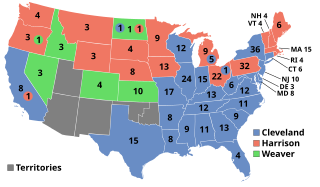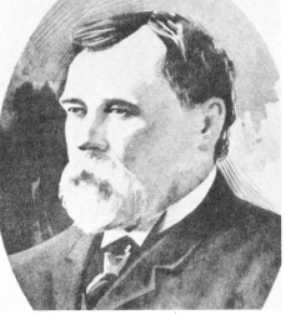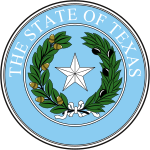
The 1892 United States presidential election was the 27th quadrennial presidential election, held on Tuesday, November 8, 1892. In the fourth rematch in American history, former Democratic President Grover Cleveland defeated incumbent Republican President Benjamin Harrison. Cleveland's victory made him the first and, to date, the only person in American history to be elected to a non-consecutive second presidential term. It was also the first of two times incumbents were defeated in consecutive elections—the second being Jimmy Carter's defeat of Gerald Ford in 1976, followed by Carter's subsequent loss to Ronald Reagan in 1980.

William Frederick Lemke was an American politician who represented North Dakota in the United States House of Representatives as a member of the Republican Party. He was also the Union Party's presidential candidate in the 1936 presidential election.

Murphy James Foster was the 31st Governor of the U.S. state of Louisiana, an office he held for two terms from 1892 to 1900. Foster supported the Louisiana Constitution of 1898, which effectively disfranchised the black majority, who were mostly Republicans. This led to Louisiana becoming a one-party Democratic state for several generations and excluding African Americans from the political system.

Charles Allen Culberson was an American political figure and Democrat who served as the 21st Governor of Texas from 1895 to 1899, and as a United States senator from Texas from 1899 to 1923.

The 1922 United States Senate elections were elections that occurred in the middle of Republican President Warren G. Harding's term. The 32 seats of Class 1 were contested in regular elections, and special elections were held to fill vacancies. With the Republicans divided between conservative and progressive factions, the Democrats gained six net seats from the Republicans while the Farmer–Labor party gained one. The Republicans retained their Senate majority.

David Browning Culberson was a Confederate soldier, a Democratic U.S. Representative from Texas and Chairman of the House Judiciary Committee.

The 1906 New York state election was held on November 6, 1906, to elect the governor, the lieutenant governor, the Secretary of State, the state comptroller, the attorney general, the state treasurer and the state engineer, as well as all members of the New York State Assembly and the New York State Senate.
In the United States, black conservatism is a political and social movement rooted in African-American communities that aligns largely with the American conservative movement, including the Christian right. Black conservatism emphasizes social conservatism, traditionalism, patriotism, capitalism and free markets. What characterizes a "black conservative" has changed over time, and proponents do not necessarily share the same political philosophy.

The 2014 United States Senate election in Texas was held on November 4, 2014, to elect a member of the United States Senate. Incumbent Republican senator and Senate Minority Whip John Cornyn ran for re-election to a third term. Primary elections were held on March 4, 2014. Since no Democratic candidate received over 50% in the first round of the primary, a runoff election was required on May 27, 2014. David Alameel, who came in first in the primary, won the runoff and became his party's nominee. In the general election, Cornyn defeated Alameel in a landslide.

The 2016 United States House of Representatives elections in Texas were held on November 8, 2016, to elect the 36 U.S. representatives from the state of Texas, one from each of the state's 36 congressional districts. The elections coincided with the 2016 presidential election, as well as other elections to the House of Representatives, elections to the United States Senate and various state and local elections. The primaries were held on March 1.

The 1922 United States Senate election in Texas was held on November 7, 1922. Incumbent Democratic U.S. Senator Charles Culberson ran for re-election to a fifth term, but lost the Democratic primary. A runoff was held between former Governor Pa Ferguson and Railroads Commissioner Earle Bradford Mayfield.
A Massachusetts general election was held on November 4, 1952 in the Commonwealth of Massachusetts. Primary elections took place on September 16.

Elections were held in Illinois on Tuesday, November 3, 1936.

A general election was held in the U.S. state of Wyoming on Tuesday, November 6, 1894. All of the state's executive officers—the Governor, Secretary of State, Auditor, Treasurer, and Superintendent of Public Instruction—were up for election. The Republican Party, helped by the strong performance of the Populist Party, which operated as a spoiler to the Democratic Party, won back the governorship and improved its margin of victory in all other statewide offices.

The 1892 Texas gubernatorial election was held to elect the Governor of Texas. Incumbent Governor Jim Hogg was re-elected to a second term with a plurality of the vote over George W. Clark, an independent Democrat with the backing of the Republican Party and state railroad interests, and Populist judge T. L. Nugent.

The 1896 Texas gubernatorial election was held to elect the Governor of Texas. Governor Charles Culberson was re-elected to a second term over Jerome C. Kearby, a Populist running with Republican support.

The 1906 Texas gubernatorial election was held to elect the Governor of Texas. Thomas Mitchell Campbell was elected to a two-year term in office.

The 1908 Texas gubernatorial election was held to elect the Governor of Texas. Governor Thomas Mitchell Campbell was re-elected to a second term in office.


















